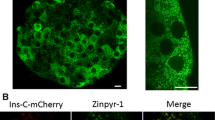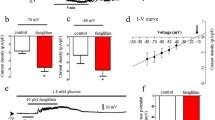Abstract
Imidazolines are regarded as a pharmacological group of insulin secretagogues with one uniform mechanism of action, namely closure of ATP-dependent K+ channels (KATP channels) and, in consequence, depolarization of the plasma membrane, Ca2+ influx and stimulation of secretion. This assumption was investigated by measuring insulin secretion from perifused pancreatic islets in response to three imidazoline compounds and comparing the characteristics of secretion with changes in membrane potential and cytosolic Ca2+ concentration [Ca2+]i of single β-cells. Phentolamine (32 µM) stimulated insulin secretion from perifused mouse islets in the presence of stimulatory (10 mM and 30 mM) and substimulatory (5 mM) glucose concentrations and even in the absence of glucose. Idazoxan in concentrations up to 500 µM was virtually ineffective in the presence of 5 mM glucose. At 10 mM glucose, there was a moderate but significant increase of secretion by idazoxan, 20 µM being nearly as effective as 100 µM. The effect of phentolamine was of slow onset and irreversible in the time frame of the experiments, while the effect of idazoxan was of fast onset and reversible. Alinidine also stimulated secretion in the presence of 10 mM glucose with fast and reversible kinetics, but in contrast to idazoxan, 100 µM was clearly more effective than 20 µM. These heterogeneous characteristics of secretion were reflected by changes of [Ca2+]i: the increase of [Ca2+]i by phentolamine was slow and only partially reversible, whereas idazoxan led to a smaller, but faster and reversible response. The increase of [Ca2+]i by phentolamine and idazoxan was abolished by the Ca2+ channel blocker D 600. Surprisingly, all three compounds depolarized the β-cell plasma membrane from a resting potential of –71 mV to about –36 mV. Again, the effect of phentolamine was slow and that of idazoxan and alinidine fast. Thus, the characteristics of phentolamine-induced secretion appear to be attributable to the consequences of KATP channel closure. It is unclear, however, why all three test compounds achieved the same degree of depolarization in spite of their known different efficiency to close KATP channels. Apparently, there are additional mechanisms involved in the action of idazoxan and alinidine, which may contribute to the obvious differences in the characteristics of secretion.
Similar content being viewed by others
Author information
Authors and Affiliations
Additional information
Received: 2 October 1998 / Accepted: 21 December 1998
Rights and permissions
About this article
Cite this article
Rustenbeck, I., Leupolt, L., Kowalewski, R. et al. Heterogeneous characteristics of imidazoline-induced insulin secretion. Naunyn-Schmiedeberg's Arch Pharmacol 359, 235–242 (1999). https://doi.org/10.1007/PL00005347
Issue Date:
DOI: https://doi.org/10.1007/PL00005347




